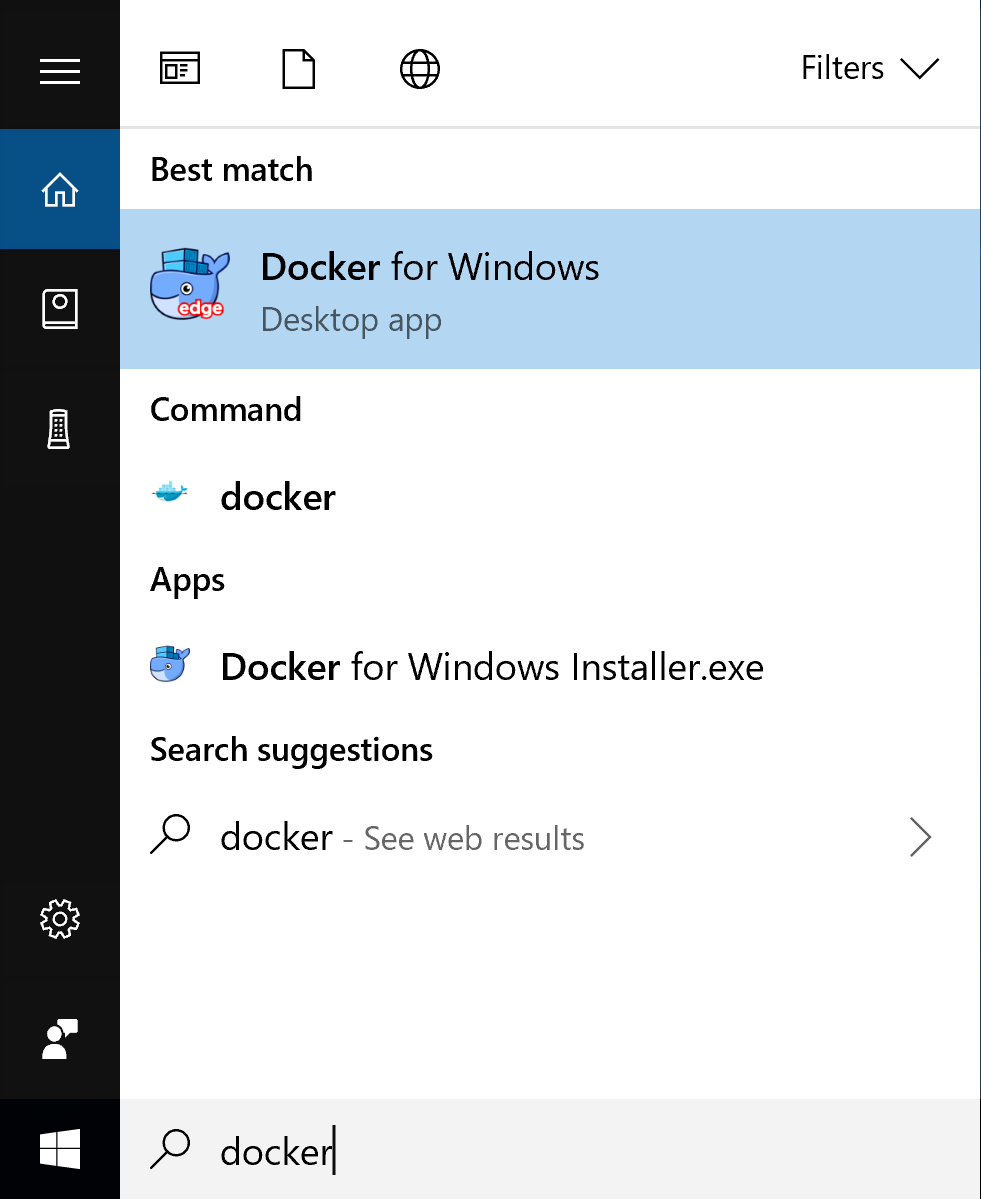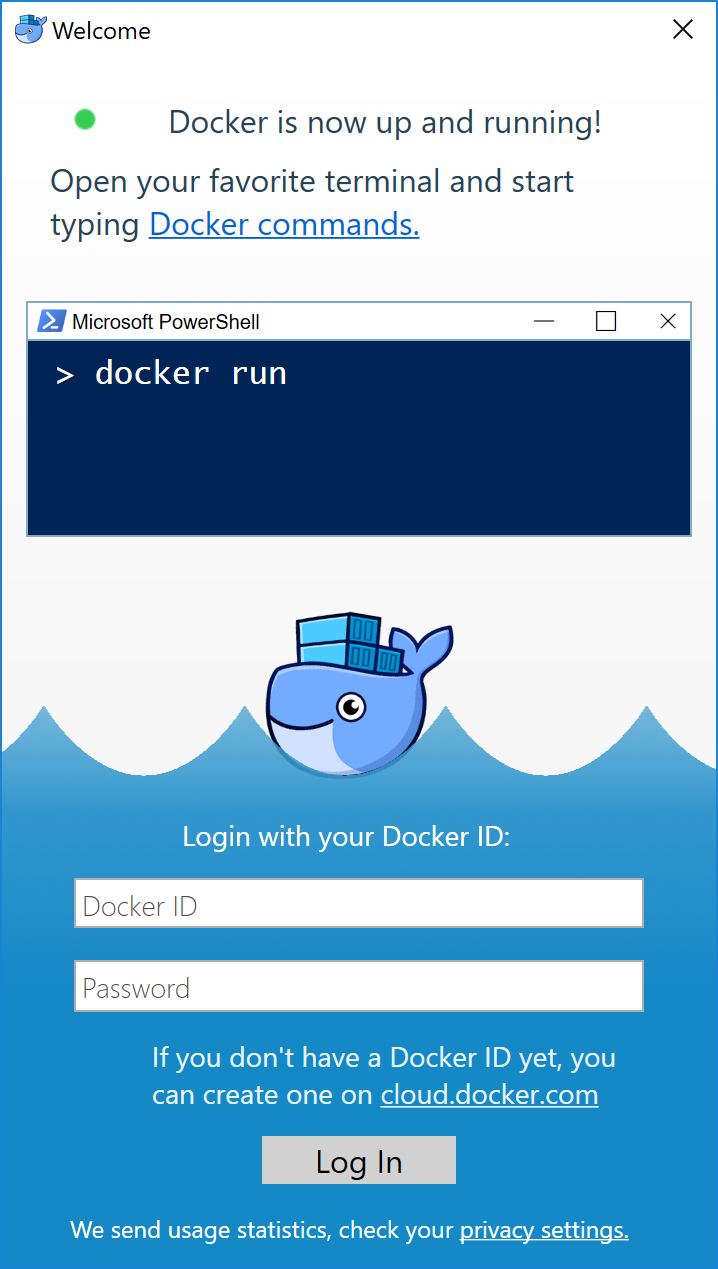Install Docker Desktop for Windows
Estimated reading time: 4 minutesDocker Desktop for Windows is the Community Edition (CE) of Docker for Microsoft Windows. To download Docker Desktop for Windows, head to Docker Hub.
What to know before you install
-
README FIRST for Docker Toolbox and Docker Machine users: Docker Desktop for Windows requires Microsoft Hyper-V to run. The Docker Desktop for Windows installer enables Hyper-V for you, if needed, and restarts your machine. After Hyper-V is enabled, VirtualBox no longer works, but any VirtualBox VM images remain. VirtualBox VMs created with
docker-machine(including thedefaultone typically created during Toolbox install) no longer start. These VMs cannot be used side-by-side with Docker Desktop for Windows. However, you can still usedocker-machineto manage remote VMs. -
System Requirements:
- Windows 10 64bit: Pro, Enterprise or Education (1607 Anniversary Update, Build 14393 or later).
- Virtualization is enabled in BIOS. Typically, virtualization is enabled by default. This is different from having Hyper-V enabled. For more detail see Virtualization must be enabled in Troubleshooting.
- CPU SLAT-capable feature.
- At least 4GB of RAM.
Note: If your system does not meet the requirements to run Docker Desktop for Windows, you can install Docker Toolbox, which uses Oracle Virtual Box instead of Hyper-V.
- What the Docker Desktop for Windows install includes: The installation provides Docker Engine, Docker CLI client, Docker Compose, Docker Machine, and Kitematic.
- Containers and images created with Docker Desktop for Windows are shared between all user accounts on machines where it is installed. This is because all Windows accounts use the same VM to build and run containers.
- Nested virtualization scenarios, such as running Docker Desktop for Windows on a VMWare or Parallels instance might work, but there are no guarantees. For more information, see Running Docker Desktop for Windows in nested virtualization scenarios
Note: Refer to the Docker compatibility matrix for complete Docker compatibility information with Windows Server.
About Windows containers
Looking for information on using Windows containers?
- Switch between Windows and Linux containers describes the Linux / Windows containers toggle in Docker Desktop for Windows and points you to the tutorial mentioned above.
- Getting Started with Windows Containers (Lab) provides a tutorial on how to set up and run Windows containers on Windows 10 or with Windows Server 2016. It shows you how to use a MusicStore application with Windows containers.
- Docker Container Platform for Windows Server 2016 articles and blog posts on the Docker website
Install Docker Desktop for Windows desktop app
-
Double-click Docker Desktop for Windows Installer.exe to run the installer.
If you haven’t already downloaded the installer (
Docker Desktop Installer.exe), you can get it from download.docker.com. It typically downloads to yourDownloadsfolder, or you can run it from the recent downloads bar at the bottom of your web browser. -
Follow the install wizard to accept the license, authorize the installer, and proceed with the install.
You are asked to authorize
Docker.appwith your system password during the install process. Privileged access is needed to install networking components, links to the Docker apps, and manage the Hyper-V VMs. -
Click Finish on the setup complete dialog to launch Docker.
Start Docker Desktop for Windows
Docker does not start automatically after installation. To start it, search for Docker, select Docker Desktop for Windows in the search results, and click it (or hit Enter).

When the whale in the status bar stays steady, Docker is up-and-running, and accessible from any terminal window.
![]()
If the whale is hidden in the Notifications area, click the up arrow on the taskbar to show it. To learn more, see Docker Settings.
If you just installed the app, you also get a popup success message with suggested next steps, and a link to this documentation.

When initialization is complete, select About Docker from the Notifications area icon to verify that you have the latest version.
Congratulations! You are up and running with Docker Desktop for Windows.
Where to go next
- Getting started introduces Docker Desktop for Windows.
- Get started with Docker is a tutorial that teaches you how to deploy a multi-service stack.
- Troubleshooting describes common problems, workarounds, and how to get support.
- FAQs provides answers to frequently asked questions.
- Stable Release Notes or Edge Release Notes.